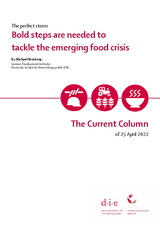The Current Column
The perfect storm
Bold steps are needed to tackle the emerging food crisis
Brüntrup, MichaelThe Current Column (2022)
Bonn: German Development Institute / Deutsches Institut für Entwicklungspolitik (DIE), The Current Column of 25 April 2022
This is almost certainly not what Germany’s Federal Minister of Food and Agriculture Cem Özdemir imagined when he called in December 2021 for an increase in the country’s food prices. The idea was to use higher prices to compensate for the costs created by new environmental requirements.
Now, the price of food is rising quite apart from such requirements. Initially, this was the result of the global COVID-19 crisis and the disruptions it caused to agricultural supply chains. Prices were then driven up further as the global economy experienced a rapid recovery and demand for agricultural products increased. With supply chains having become weakened, this caused many prices to soar to their highest levels since the last agricultural price crisis between 2011 and 2013. And on top of all this comes the Ukraine war. Ukraine, Russia and Belarus are major players on the global agricultural markets. In the short term, this is affecting wheat, sunflowers, fertiliser, gas and energy, but, in the medium term, the impact will be felt by all agricultural markets. We are seeing a decrease in purchasing power, while the global South faces a particular threat of food shortages, malnourishment, hunger and bread riots. The latter unrest can arise where populations are especially dependent on food imports and the political landscape is already fragile. Right now, countries such as Lebanon and Egypt are at particular risk in this regard. At the same time, many other nations and low-income population groups everywhere are already painfully aware of the impact of the high food prices. These circumstances could also give rise to new inter-state conflicts.
The latest agricultural price crisis is complex. How can we use short- and long-term measures to mitigate its negative effects? We must first ensure, wherever possible, that exports of food and means of production are not hindered. While an end to the war would clearly be phenomenal, not least for food supplies in Ukraine itself, it would not spell the end of this issue. It will likely be necessary to find non-maritime routes for the country’s exports. Sanctions imposed on Russia and Belarus, such as the expulsion of banks from the SWIFT system, should include exemptions for these products or allow them to be paid for using alternative methods. If Germany is not going to boycott gas imports for fear of the enormous economic consequences, then it should certainly take account of the looming threat of food shortages and avoid double standards here.
Other measures include massively stepping up food aid to the poorest nations, such as Yemen and Somalia, and making (larger) cash transfers to poor households, not only in developing countries, but also in wealthier nations such as Germany. The prices of basic foods could be reduced by cutting import duties and excise tax or providing subsidies. Poor countries could be given assistance with financing food imports. Speculation on food prices and hoarding of agricultural products should be restricted wherever possible. Agricultural products of sufficiently high quality could be diverted from animal farming and bioenergy production for human use, for instance, by means of temporary levies. Some legislatures provide for the reduction of fuel blending quotas in emergencies. Nonetheless, in the short term, reallocations of this kind are only feasible for a small number of high-quality products, such as wheat. They could be more effective in the medium term if changes are made to the species and varieties of crops cultivated and the techniques used to grow them. If the next harvest is to be secured, then it is necessary to safeguard supplies of inputs such as mineral fertiliser, and access to loans and insurance policies/guarantees against significant drops in price later on, and thus to reduce the risks for farmers.
In the longer term, conclusions should be drawn from these crises and others, such as drought, which are being intensified further by climate change. The agricultural industry and food systems must become more resilient, but not at the expense of efforts to improve sustainability. Agro-ecological cultivation methods, such as nitrogen fertilisation by the growing of legumes (e.g. clover, broad beans and soya beans), the use of agroforestry systems, and humus development, improve and stabilise agricultural production. In regions with low crop intensity and depleted soils, such as sub-Saharan Africa, there is a need to increase production, not least through the use of external inputs, irrigation and other technological solutions.
It is also essential to optimise the non-cultivation aspects of food systems, such as warehousing, processing, consumption and even re-utilisation. Production systems and trade flows should be diversified and warehousing and social security expanded in order to boost resilience. However, reverting to local supply systems only, a much discussed option at present, is hardly the way to go, as fluctuations in local harvests could quickly lead to local food crises. Continuing to grow a certain proportion of crops for animal feed and bioenergy production is also quite advisable, as it provides a food buffer.
Global food security must be achieved against the backdrop of a complex target system with a high degree of uncertainty, multiple distribution and justice issues, and ecological services that are not market-ready. Clear and strict national and inter-governmental rules are just as vital here as state support. This requires that we update the way the global food system is governed.


